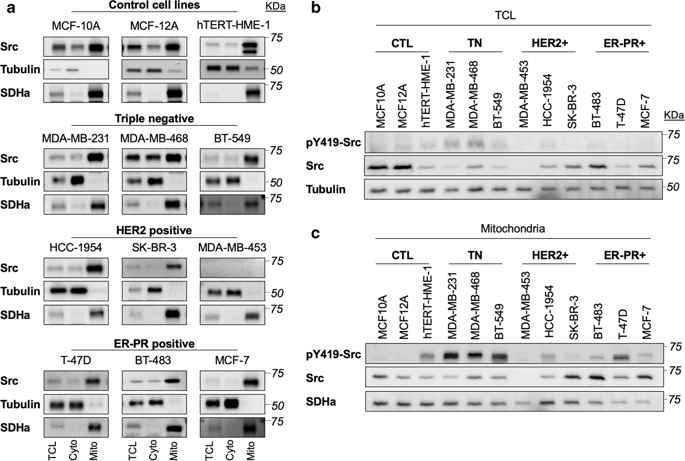当前位置:
X-MOL 学术
›
Cell Death Dis.
›
论文详情
Our official English website, www.x-mol.net, welcomes your feedback! (Note: you will need to create a separate account there.)
Intramitochondrial Src kinase links mitochondrial dysfunctions and aggressiveness of breast cancer cells.
Cell Death & Disease ( IF 9 ) Pub Date : 2019-12-09 , DOI: 10.1038/s41419-019-2134-8 Marie-Ange Djeungoue-Petga 1, 2 , Olivier Lurette 1, 2 , Stéphanie Jean 1, 2 , Geneviève Hamel-Côté 1, 2 , Rebeca Martín-Jiménez 1, 2 , Marine Bou 1, 2 , Astrid Cannich 3, 4 , Patrick Roy 5 , Etienne Hebert-Chatelain 1, 2
Cell Death & Disease ( IF 9 ) Pub Date : 2019-12-09 , DOI: 10.1038/s41419-019-2134-8 Marie-Ange Djeungoue-Petga 1, 2 , Olivier Lurette 1, 2 , Stéphanie Jean 1, 2 , Geneviève Hamel-Côté 1, 2 , Rebeca Martín-Jiménez 1, 2 , Marine Bou 1, 2 , Astrid Cannich 3, 4 , Patrick Roy 5 , Etienne Hebert-Chatelain 1, 2
Affiliation

|
High levels and activity of Src kinase are common among breast cancer subtypes, and several inhibitors of the kinase are currently tested in clinical trials. Alterations in mitochondrial activity is also observed among the different types of breast cancer. Src kinase is localized in several subcellular compartments, including mitochondria where it targets several proteins to modulate the activity of the organelle. Although the subcellular localization of other oncogenes modulates the potency of known treatments, nothing is known about the specific role of intra-mitochondrial Src (mtSrc) in breast cancer. The aim of this work was to determine whether mtSrc kinase has specific impact on breast cancer cells. We first observed that activity of mtSrc is higher in breast cancer cells of the triple negative subtype. Over-expression of Src specifically targeted to mitochondria reduced mtDNA levels, mitochondrial membrane potential and cellular respiration. These alterations of mitochondrial functions led to lower cellular viability, shorter cell cycle and increased invasive capacity. Proteomic analyses revealed that mtSrc targets the mitochondrial single-stranded DNA-binding protein, a regulator of mtDNA replication. Our findings suggest that mtSrc promotes aggressiveness of breast cancer cells via phosphorylation of mitochondrial single-stranded DNA-binding protein leading to reduced mtDNA levels and mitochondrial activity. This study highlights the importance of considering the subcellular localization of Src kinase in the development of potent therapy for breast cancer.
中文翻译:

线粒体内的Src激酶将线粒体功能障碍与乳腺癌细胞的侵袭性联系起来。
高水平和高活性的Src激酶在乳腺癌亚型中很常见,目前已经在临床试验中测试了该激酶的几种抑制剂。在不同类型的乳腺癌中也观察到线粒体活性的改变。Src激酶位于几个亚细胞区室,包括线粒体,在其中它靶向几种蛋白质来调节细胞器的活性。尽管其他致癌基因的亚细胞定位可调节已知治疗方法的效力,但对于线粒体内Src(mtSrc)在乳腺癌中的特殊作用还一无所知。这项工作的目的是确定mtSrc激酶是否对乳腺癌细胞有特异性影响。我们首先观察到mtSrc的活性在三阴性亚型的乳腺癌细胞中更高。专门针对线粒体的Src的过度表达降低了mtDNA水平,线粒体膜电位和细胞呼吸。线粒体功能的这些改变导致较低的细胞活力,较短的细胞周期和增加的侵袭能力。蛋白质组学分析表明,mtSrc靶向线粒体单链DNA结合蛋白,后者是mtDNA复制的调节剂。我们的发现表明,mtSrc通过线粒体单链DNA结合蛋白的磷酸化促进乳腺癌细胞的侵袭性,从而导致mtDNA水平和线粒体活性降低。这项研究强调了在开发有效的乳腺癌治疗方案中考虑Src激酶亚细胞定位的重要性。线粒体膜电位和细胞呼吸。线粒体功能的这些改变导致较低的细胞活力,较短的细胞周期和增加的侵袭能力。蛋白质组学分析表明,mtSrc靶向线粒体单链DNA结合蛋白,后者是mtDNA复制的调节剂。我们的发现表明,mtSrc通过线粒体单链DNA结合蛋白的磷酸化促进乳腺癌细胞的侵袭性,从而导致mtDNA水平和线粒体活性降低。这项研究强调了在开发有效的乳腺癌治疗方案中考虑Src激酶亚细胞定位的重要性。线粒体膜电位和细胞呼吸。线粒体功能的这些改变导致较低的细胞活力,较短的细胞周期和增加的侵袭能力。蛋白质组学分析显示,mtSrc靶向线粒体单链DNA结合蛋白,后者是mtDNA复制的调节剂。我们的发现表明,mtSrc通过线粒体单链DNA结合蛋白的磷酸化促进乳腺癌细胞的侵袭性,从而导致mtDNA水平和线粒体活性降低。这项研究强调了在开发有效的乳腺癌治疗方案中考虑Src激酶亚细胞定位的重要性。蛋白质组学分析显示,mtSrc靶向线粒体单链DNA结合蛋白,后者是mtDNA复制的调节剂。我们的发现表明,mtSrc通过线粒体单链DNA结合蛋白的磷酸化促进乳腺癌细胞的侵袭性,从而导致mtDNA水平和线粒体活性降低。这项研究强调了在开发有效的乳腺癌治疗方案中考虑Src激酶亚细胞定位的重要性。蛋白质组学分析显示,mtSrc靶向线粒体单链DNA结合蛋白,后者是mtDNA复制的调节剂。我们的发现表明,mtSrc通过线粒体单链DNA结合蛋白的磷酸化促进乳腺癌细胞的侵袭性,从而导致mtDNA水平和线粒体活性降低。这项研究强调了在开发有效的乳腺癌治疗方案中考虑Src激酶亚细胞定位的重要性。
更新日期:2019-12-09
中文翻译:

线粒体内的Src激酶将线粒体功能障碍与乳腺癌细胞的侵袭性联系起来。
高水平和高活性的Src激酶在乳腺癌亚型中很常见,目前已经在临床试验中测试了该激酶的几种抑制剂。在不同类型的乳腺癌中也观察到线粒体活性的改变。Src激酶位于几个亚细胞区室,包括线粒体,在其中它靶向几种蛋白质来调节细胞器的活性。尽管其他致癌基因的亚细胞定位可调节已知治疗方法的效力,但对于线粒体内Src(mtSrc)在乳腺癌中的特殊作用还一无所知。这项工作的目的是确定mtSrc激酶是否对乳腺癌细胞有特异性影响。我们首先观察到mtSrc的活性在三阴性亚型的乳腺癌细胞中更高。专门针对线粒体的Src的过度表达降低了mtDNA水平,线粒体膜电位和细胞呼吸。线粒体功能的这些改变导致较低的细胞活力,较短的细胞周期和增加的侵袭能力。蛋白质组学分析表明,mtSrc靶向线粒体单链DNA结合蛋白,后者是mtDNA复制的调节剂。我们的发现表明,mtSrc通过线粒体单链DNA结合蛋白的磷酸化促进乳腺癌细胞的侵袭性,从而导致mtDNA水平和线粒体活性降低。这项研究强调了在开发有效的乳腺癌治疗方案中考虑Src激酶亚细胞定位的重要性。线粒体膜电位和细胞呼吸。线粒体功能的这些改变导致较低的细胞活力,较短的细胞周期和增加的侵袭能力。蛋白质组学分析表明,mtSrc靶向线粒体单链DNA结合蛋白,后者是mtDNA复制的调节剂。我们的发现表明,mtSrc通过线粒体单链DNA结合蛋白的磷酸化促进乳腺癌细胞的侵袭性,从而导致mtDNA水平和线粒体活性降低。这项研究强调了在开发有效的乳腺癌治疗方案中考虑Src激酶亚细胞定位的重要性。线粒体膜电位和细胞呼吸。线粒体功能的这些改变导致较低的细胞活力,较短的细胞周期和增加的侵袭能力。蛋白质组学分析显示,mtSrc靶向线粒体单链DNA结合蛋白,后者是mtDNA复制的调节剂。我们的发现表明,mtSrc通过线粒体单链DNA结合蛋白的磷酸化促进乳腺癌细胞的侵袭性,从而导致mtDNA水平和线粒体活性降低。这项研究强调了在开发有效的乳腺癌治疗方案中考虑Src激酶亚细胞定位的重要性。蛋白质组学分析显示,mtSrc靶向线粒体单链DNA结合蛋白,后者是mtDNA复制的调节剂。我们的发现表明,mtSrc通过线粒体单链DNA结合蛋白的磷酸化促进乳腺癌细胞的侵袭性,从而导致mtDNA水平和线粒体活性降低。这项研究强调了在开发有效的乳腺癌治疗方案中考虑Src激酶亚细胞定位的重要性。蛋白质组学分析显示,mtSrc靶向线粒体单链DNA结合蛋白,后者是mtDNA复制的调节剂。我们的发现表明,mtSrc通过线粒体单链DNA结合蛋白的磷酸化促进乳腺癌细胞的侵袭性,从而导致mtDNA水平和线粒体活性降低。这项研究强调了在开发有效的乳腺癌治疗方案中考虑Src激酶亚细胞定位的重要性。


























 京公网安备 11010802027423号
京公网安备 11010802027423号